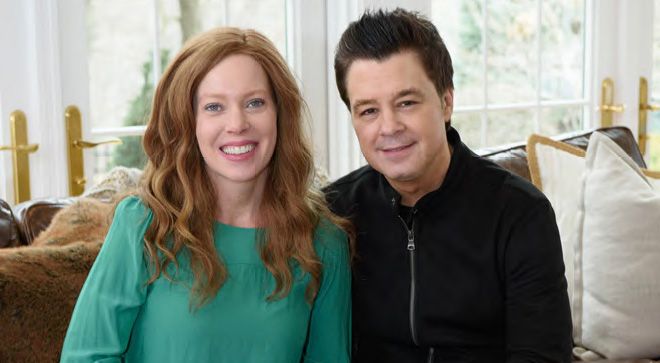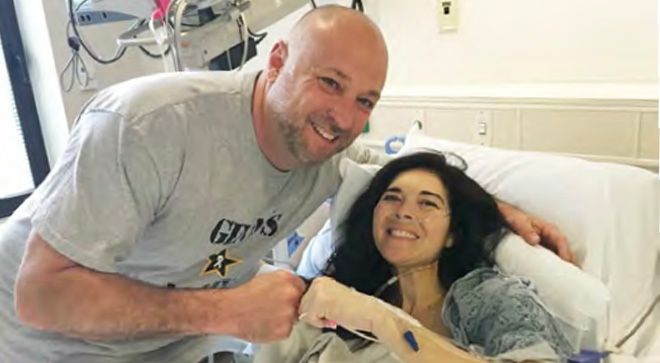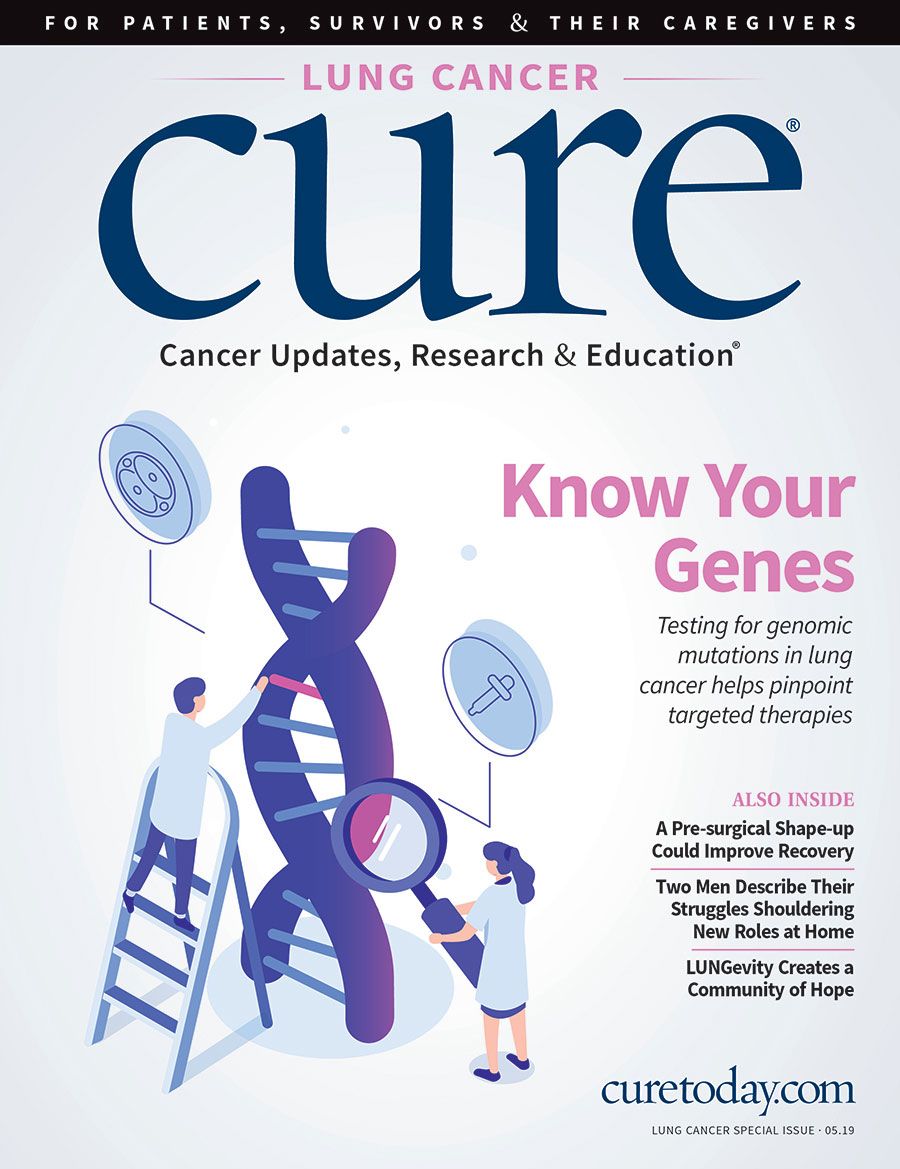Publication
Article
CURE
Overnight Caregiver: Two Husbands Embrace Caregiving for Wives with Lung Cancer
Author(s):
Two husbands embrace changing and challenging roles at home when they learn of their spouses’ cancer diagnoses.
In 2015, Greg and Gina Hollenbeck were like many busy young couples raising families. Their lives in Collierville, Tennessee, revolved around their two boys (Hudson and Hayden, then 11 and 7), their jobs, their families and each other. Gina Hollenbeck, 38 at the time and a registered nurse, was a self-described “career-oriented business woman” working full time in a surgery center and as clinical director of a nonprofit organization. Greg Hollenbeck was a pilot for FedEx. Life was good — a controlled whirlwind of school, sports and the day-to-day business of family life.
Then a diagnosis took them both by surprise: Gina Hollenbeck, who has no family history of cancer and never smoked, was told she had stage 4 lung cancer. Suddenly, what she called their “traditional” marriage was flipped on its head as the couple went into survival mode. As she focused on her treatment, Greg Hollenbeck became the caregiver and family manager — roles for which they were not fully prepared.
That situation is becoming increasingly common as more younger women are receiving lung cancer diagnoses. A study published in the New England Journal of Medicine in May 2018 showed that rates of lung cancer incidence among women born since the mid-1960s are now higher than the rates among men — and this trend is not fully explained by differences in smoking behaviors between men and women. To shed light on this shift, researchers say, more studies of sex-specific risks for lung cancer must be done.
Now, four years after his wife’s diagnosis, Greg Hollenbeck describes the shock: He went numb. Then he got mad — and he got busy. “I went into fight mode,” he says, focusing on his wife’s immediate care, finding the right medical team and trying to keep the boys’ routines going. “We were both very independent people, especially her,” he says. “She’s a go-getter, and she wanted to do everything from dishes and laundry to feeding the kids. After her diagnosis, she couldn’t. It made me realize how much I wasn’t doing around the house.”

A quote on GINA HOLLENBECK’S wrist is a reminder to see the positive in their journey.
CHANGING ROLES
Relationships, including the roles and respon­sibilities of each person, often come under a microscope following a cancer diagnosis. “The dynamics that already existed in the partnership set the tone for what happens next,” says Sarah Paul, M.S.W., a licensed clinical social worker and child, adolescent and young adult program manager at CancerCare in New York City, a national orga­nization providing free professional support services to those affected by cancer. For some men, taking on new roles in the relationship poses an additional challenge, on top of their partner having cancer, she says.
These new duties might include acting as a patient advocate, which requires organiza­tion, talking with medical professionals and managing the details of treatment. Some men become information managers, responsible for updating friends and family on their partner’s status. Other men may step into the role of primary parent for the first time — a particular challenge when Mom has been the main caretaker and children might not be used to listening to Dad, Paul says. “Some dads say things like ‘I’m not a good parent’ when they feel like the kids aren’t listening to them,” she says.
The changes can be tough on women too, especially if their relation­ship tended toward a more traditional gender split of roles. “Little things she did may fall to the wayside,” Paul says. “It can be overwhelming if you’re not prepared for it.” Still, such role reversals aren’t always negative. “There’s often an opportunity to learn more about your partner and strengthen your relation­ship,” she says.
The caregiver role can deepen bonds not only between partners, but between family members, too. That’s been the case for Jim Filipiak of Ottawa Hills, Ohio, whose 48-year-old wife, Bobbi, learned of her lung cancer shortly after giving birth to their daughter, Kate, now 6. He is a musician in a local band, and his nontraditional job has always given him the flexibility to be his family’s on-call person, he says, allowing him to help take care of family members who’ve needed him through the years. That flexibility and those close relationships were incredibly impor­tant to him after his wife’s diagnosis, he says. “Our family members were and continue to be a source of great support to us,” Filipiak says.

JIM FILIPIAK with his wife, BOBBI.
PRACTICAL CHALLENGES
Finding support is key to managing the physical, emotional and practical stresses for men in the caregiver role, especially because men tend to experience the role in more isolation, says Allison Applebaum, Ph.D., a licensed clinical psychologist and director of the Caregivers Clinic at Memorial Sloan Kettering Cancer Center in New York City. Some men are self-isolating, saying things like “I feel alone in this role,” she says, adding that others struggle to find a support network because there are fewer men in the caregiver role.
Caregivers also need support for the practical challenges they face. Men who manage transporting their partner to treatment and medical appointments and providing care at home may require help with taking care of young children or chauffeuring older kids to sports and other activities. They may also need to ask for time off work to care for their partner, which can create financial stress or job uncertainty. To find support, they may need to ask for help — something that isn’t always easy to do, Paul says.

FILIPIAK, a musician, relied on music as an outlet.
Although little research has been done on gender differences in caregiving, Applebaum says that generally, an “ethic of care” is instilled in women early on: “It’s normalized among women to be a caregiver.”
Paul agrees, adding, “Women tend to be nurturers and are more likely to ask for help. Men tend to be more private. They don’t want to be seen as vulnerable.”
Greg Hollenbeck says he feels fortunate that his fellow pilots pitched in to help, picking up his flights so he could be home with his wife but still get paid. “Some were good friends of mine, and some guys I didn’t even know,” he says. “And Gina’s mom and my parents, as well as parents of other kids, helped get the kids to practices and keep the routine going.”
Still, he relates to wanting to keep things private. “Once we got to a place where she was getting better, I wanted to go fly,” he says. “I got to sit in a cockpit with some dude I didn’t know, who didn’t know what was going on with me, and not talk about it.”
Between a wife with a new diagnosis and a newborn daughter, Filipiak also had to get comfortable with asking for help. “I had to be able to say, ‘I need you to come over now. I need to be with her at this appointment, and I don’t want someone who’s not a family member watching this baby,’” he says.
MANAGING STRESS
Filipiak describes that period as overwhelming. “(Before,) we lived independent lives, and we were an energetic couple with an active social life,” he says. “Even if you took cancer out of it, having a child is overwhelming and a complete lifestyle change.”
His stress level rose, he says, because the two of them were unaware of the growing number of women in their 40s, who had never smoked, getting lung cancer. “It was surreal. For the first year, I was pretty much in shock,” he says.
Caregivers can face different sets of challenges depending on the type of cancer their partner has, says Shirley Otis-Green, M.S.W., OSW-C, a licensed clinical social worker in Toluca Lake, California and founder of Collaborative Caring, a consulting firm that works with cancer and palliative care programs.
“A cancer center may have a wealth of resources, but the pictures, stories and examples in those resources may be for an ‘other’ (such as a much older caregiver) and may not resonate with him, leading to increased feelings of isolation,” she says.
Applebaum tries to address that isolation when she tells caregivers that cancer is a disease of the family. “Sometimes people say, ‘I’m not the patient, so why do my feelings matter?’” she says. “But in a family, you’re all affected.”
She often asks the men who come to her center: What brought you to this role? “Some say, ‘I’m the only person available.’ Others say, ‘I’m bound by the vows I made,’ while others say, ‘I watched my father take care of my mother,’” she says. “I tell them we have a counseling center here because coping with cancer is very challenging. We normalize that need for support.”
Greg Hollenbeck received a folder about support services from the hospital but put it aside. “That may be more a man thing,” he says. He noted that counseling was available. “I never used it,” he says, “but it was good to know it was there.”

GREG HOLLENBECK says he went numb after learning of his wife, GINA’s, stage 4 lung cancer diagnosis.
Support groups specifically for lung cancer caregivers, such as those offered by CancerCare, can also be a good resource — especially an online group for someone who is not comfortable with a face-to-face situation. “It’s less commitment than in person,” Paul says. “You don’t have to identify with a picture, and you can use a username.”
Applebaum, who has written a new book, “Cancer Caregivers,” says men may also benefit from a caregiver mentoring program, an informal support system that pairs experienced and new caregivers. Comprehensive cancer centers and organizations, such as the American Cancer Society, can help caregivers connect with resources and support groups. “Sometimes, just one conversation is all it takes,” she says. “Some people just want information. It’s about finding the right type of support for you.”
Filipiak says he sees no shame in therapy or in reaching out for support, although he didn’t take part in support groups recommended to him. Instead, he relies on his close relationships with friends and family and taking walks with his beagle to clear his head. “Being able to play music in the evenings really helped, too, and continues to help,” he says.
Paul encourages caregivers to look after their own well-being. Something as simple as a 10-minute walk or meeting a friend for coffee can help relieve stress, as can maintaining healthy habits, such as exercising, eating well, getting enough sleep and seeing a doctor for personal health care, she says.
Ultimately, balancing your own needs as a caregiver, those of your partner, and the needs of the relationship itself, comes down to communication, clear expectations and patience, according to Paul. “There is no guidebook for how to be a completely different person than you were two months ago,” she says. “It’s challenging.”





